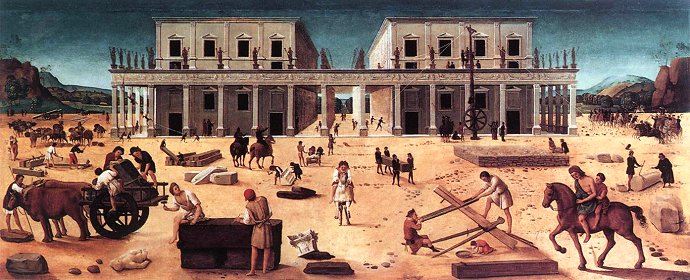THE BUILDING OF A PALACE. By Esther Schuerman Artist -Piero di Cosimo was an unsalaried apprentice ofCosimo Rosselli. Roselli was summoned to Rome by Pope Sixtus IV, and Piero di Cosimo went with him and spent two years there. By the late 1480's, Piero di Cosimo was established as an independent artist in Florence as one of the most original and imaginative artists in that city. About half of his work consists of religious subjects. In addition, he painted portraits, made a significant contribution to landscape painting, was a marvelous painter of animals and is known for his mythological scenes and naturalistic style. His works were influenced by Leonardo da Vinci and Filippino Lippi and other contemporary artists, and his pupils included Andrea del Sarto. There are no signed, documented, or dated works by Piero de Cosimo. For centuries he was best known for his personal eccentricity. He was afflicted by partial paralysis which often prevented him from working, and he died in Florence in self-imposed solitude. Subject -There have been several differing opinions on what the subject matter is based. It may be part of a series of other works which depict important episodes from early history such as the "Golden Age". It has also been proposed that it may represent the origins of architecture or an allegory on the art of building. It does seem clear that the painting represents on ideal structure, not a real one. Painting -What we see in this painting is an accomplished example of Renaissance perspective painting, but we also see evidence ofPiero di Cosimo's inventive trend in the curious perspective of some of the figures and animals. The painting shows extensive space and a scattering of rather rigid, spindly figures. All kinds of activities associated with the building of a palace are depicted as numerous workmen are preparing for it's completion. We see the palace has two wings connected by columns and terraces. Statues similar to those in the Ringling Museum courtyard are lined around the roof line. Decorative landscapes are on either side of the building. On the right of the building, we see a group arriving on horseback, who are probably a ducal entourage. The painting has great aesthetic merit as well as being of cultural interest as an illustration of contemporary architectural procedures. Historic Context -The ideal beauty of classical art held a central place in society during the Italian Renaissance and was often seen through architecture's combination of philosophy, mathematics and archeology. Provenance -This painting was in the Emile Gavet collection in Paris. Later it was owned by William K. Vanderbilt and inherited by Mrs. Oliver Belmont of Newport, R.I. It was acquired by John Ringling through Duveen in London in 1928-1929. Bequest of John Ringling 1936.
|
